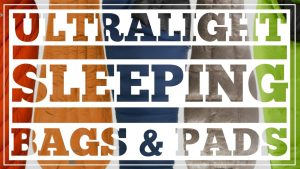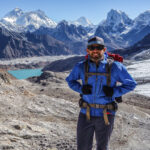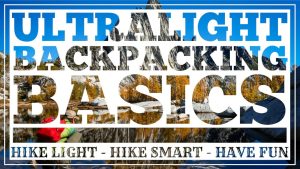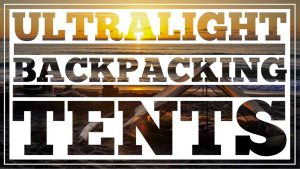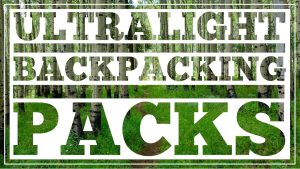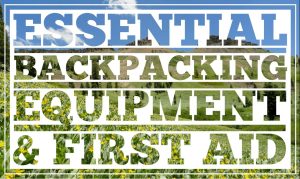Ultralight Footwear & Trekking Poles – Episode 8
We independently test everything we recommend.
Buying through links on our site supports our work.
Ultralight Backpacking Footwear & Trekking Poles
When it comes to saving energy on the trail, choosing lightweight footwear is just about the most important decision you can make. Carrying weight on your feet is very costly for energy consumption. in fact, weight carried on your feet is about 4-6 times more costly than weight carried on your back.
When I switched from hiking boots to trail running shoes a few years ago, I was able to shave about three pounds from my feet. That simple three pound switch had the feeling of unloading 12-18 pounds from my backpack.
Switching to lightweight footwear made an incredible difference on my treks. I had the energy to hike more miles, my legs felt great, and I completely eliminated blisters from my backpacking trips. It was a complete game changer for me and I won’t be going back to boots anytime soon.
Why Not Boots?
Some backpackers still swear by boots, but most lightweight backpackers leave their heavy footwear at home and choose a lightweight alternative. Running shoes and trail runners are an excellent choice for lightweight hikers.
If you’re not carrying a heavy pack, you don’t need the small amount of ankle support that boots provide. In addition, boots are expensive and will take a long time to break in. Even after your heavy boots are broken in, they can still cause painful blisters. This is mostly due to the fact that boots don’t breathe well. That will keep your hardworking feet soft and vulnerable all day long.
I’ve backpacked in many different pairs of boots over the years and it has always been the same story. Any time I tried to hike big miles my feet were torn up. Eventually I got sick of it and started looking for a better solution.
Another important consideration with boots is that even though most companies claim their boots are waterproof, your feet will almost always be wet. Boots don’t breathe well, so even in dry weather, your feet are going to get wet from sweat.
When it’s raining out, your boots might keep your feet dry for a bit, but eventually your feet will get wet. Water will run down your legs and into your boots. And once boots get wet, they stay wet for a very long time. They also become incredibly heavy.
For more info on making the switch, check out our article; 5 Reasons to Ditch Your Hiking Boots.
A Lightweight Alternative
A much better option is a pair of lightweight, quick-dry shoes like running shoes or trail runners. Many traditional backpackers are skeptical that running shoes provide enough protection and structure for backpacking, but let me tell you from experience, they do.
I hiked the entire PCT in trail running shoes. I forded rivers, summated mountains, crossed snowfields, and even hiked entire weeks in the rain. My trail shoes were one of the main reasons I was able to complete my thru-hike and never once did I wish that I had a pair of boots.
Running shoes will keep your feet dry when the weather is nice because they have great ventilation. When it rains, your feet will get wet (just like they would in boots), but your shoes will still be comfortable to hike in and they will dry quickly when the rain stops.
Shoe Recommendations:
When choosing a backpacking shoe, look for one that is comfortable with a soft, thicksole and good traction on the bottom. You also don’t want to choose anything that’s going to require a break-in period. They should feel comfortable the moment you put them on.
Backpacking shoes will compress over time, but they usually last around 500-600 trail miles, depending on the model. You might also want to choose a shoe that’s about a half size larger than what you normally wear, because feet tend to swell over long days of hiking.
When it comes to choosing between running shoes, trail runners, or some hybrid, I almost always choose trail running shoes because they’re very durable and lightweight. Here are a couple of my favorites:
- Saucony Peregrine 7 – Our go-to hiking shoe right now is the Saucony Peregrine 7 (men’s and women’s)and we absolutely love them. They have comfortable padding, fantastic traction, and a soft sole.
- Altra Superior 3.0 Trail Runners – We love how lightweight and comfortable these updated Altra Trail Runners (women’s and men’s) are right out of the box. They’re great for trail running, but also have superior traction for rugged mountain hiking.
Socks are another important consideration for comfort. If you’re not using boots, you won’t need heavy wool socks and liners to protect your feet. Instead, you can use small synthetic socks, such as Balega socks with decent padding. Also, a light pair of trail gators will help to keep debris out of your feet.
Camp shoes should be considered optional, but they can be nice on really wet trips. Most ultralight backpackers choose to leave camp shoes at home because they are already wearing comfortable shoes.
Trekking Poles
Trekking poses shouldn’t be considered essential, but many lightweight backpackers love them. They can be very handy on the trail and they’re especially good at easing knee pain on steep uphill and downhill sections.
Trekking poles are also helpful for increasing yourbalance when crossing streams, snowfields, or on loose gravel. They can be used to support many ultralight shelters as well, which will help reduce tent poll weight.
Carbon Fiber vs Aluminum
Your main choice with trekking poles is between carbon fiber and aluminum materials. Carbon fiber will be much lighter, but it will also cost more and be a slightly more fragile. The weight savings can definitely be worth the price tag though, depending on your preferences.
Length-adjustable poles are very convenient and make sure your poles have a comfortable handle – trekking poles can cause blisters on your hands. Flick locks tend to work slightly better than twist locks, which will require a little more maintenance over time.
Trekking Pole Downsides
You should try to be careful while using your trekking poles because they can break. The most common breaks occur when poles get stuck in rocks or when hikers put a lot of weight on them while falling down.
Also, trekking poles will actually increase the amount of energy you expend while hiking, but trekking pole users believe the tradeoff is well worth it.
In addition, trekking poles will occupy your hands, which means that taking a water bottle out, checking a map, or taking a picture will be slightly more cumbersome.
You may experience hand blisters and arm fatigue while you’re getting used to new trekking poles. When your arms get sore, you’ll probably throw your trekking poles on your pack, which will increase your pack weight.
My Preference
A large portion of the lightweight backpacking community absolutely loves trekking poles. They would never consider hiking without them and I can see why. Personally, I usually like to keep my hands free on the trail, so I don’t generally bring them along when I go hiking. Though I must admit, the older I get the more I seem to take them on my trips.
For recommendations on the best trekking poles, check out our trekking pole guide.
Hopefully that gives you some good ideas on how to stay light and agile on the trail. Leave those boots at home and come join us for a blister free hike.
Hike light, hike smart, and have fun.
POPULAR CLEVERHIKER CONTENT
- BEST BACKPACKING TENTS
- BEST LIGHTWEIGHT BACKPACKS
- BEST SLEEPING BAGS
- TOP GEAR PICKS
- 12 BEGINNER BACKPACKING BLUNDERS
- 5 REASONS TO DITCH YOUR HIKING BOOTS
- BEST BACKPACKING STOVES
- BEST SLEEPING PADS
- BEST HAMMOCKS
- 21 TIPS FOR THE FIRST TIME THRU-HIKER
- LIGHTWEIGHT GEAR TUTORIAL VIDEOS
- ESSENTIAL TRAIL SKILLS TUTORIAL VIDEOS
MORE EPISODES IN THIS SERIES
View all